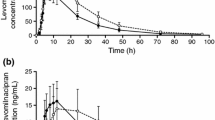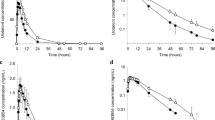Abstract
Background and objective
Armodafinil, a wakefulness-promoting agent, is the pure R-enantiomer of racemic modafinil. The objective of this article is to summarize the results of three clinical drug-interaction studies assessing the potential for drug interactions of armodafinil with agents metabolized by cytochrome P450 (CYP) enzymes 1A2, 3A4 and 2C19. Study 1 evaluated the potential for armodafinil to induce the activity of CYPlA2 using oral caffeine as the probe substrate. Study 2 evaluated the potential for armodafinil to induce gastrointestinal and hepatic CYP3A4 activity using intravenous and oral midazolam as the probe substrate. Study 3 evaluated the potential for armodafinil to inhibit the activity of CYP2C19 using oral omeprazole as the probe substrate.
Methods
Healthy men and nonpregnant women aged 18–5 years with a body mass index of ≤30 kg/m2 each participated in one of three open-label studies. Studies 1 and 2 were sequential design studies in which caffeine (oral 200 mg) or midazolam (2 mg intravenously followed by 5 mg orally) was administered before initiation of oral armodafinil administration and again after at least 22 days of oral armodafinil administration at 250 mg/day. Study 3 was a two-way crossover study in CYP2C19 extensive metabolizers to whom omeprazole (oral 40 mg) was administered alone or with oral administration of armodafinil 400 mg 2 hours before the omeprazole dose. Pharmacokinetic samples were obtained for caffeine, midazolam and omeprazole for up to 48 hours postdose. The primary pharmacokinetic parameters included the area under the plasma concentration-time curve from time zero to infinity (AUC∞) and the maximum observed drug plasma concentration (Cmax). Safety and tolerability were also assessed.
Results
A total of 77 healthy subjects participated in the three studies (study 1, n = 29; study 2, n = 24; study 3, n = 24). Prolonged armodafinil administration had no effect on the Cmax or the AUC of oral caffeine compared with administration of caffeine alone. However, prolonged administration of armodafinil reduced the AUC of midazolam after intravenous and oral doses by approximately 17% and 32%, respectively, and decreased the Cmax of oral midazolam by approximately 19% compared with administration of midazolam alone. Armodafinil coadministration increased the AUC of oral omeprazole by approximately 38% compared with administration of omeprazole alone. Armodafinil alone or in combination with each of the three probe substrates was well tolerated, with headache and dizziness being the most commonly reported adverse events.
Conclusions
Armodafinil did not induce CYP1A2 but was a moderate inducer of CYP3A4 and a moderate inhibitor of CYP2C19 in healthy subjects. Armodafinil was generally well tolerated when administered with caffeine, midazolam or omeprazole. Dosage adjustments may be required for drugs that are substrates of CYP3A4 (e.g. Ciclosporin, triazolam) and CYP2C19 enzymes (e.g. diazepam, phenytoin) when administered with armodafinil.














Similar content being viewed by others
References
Robertson Jr P, Hellriegel ET. Clinical pharmacokinetic profile of modafinil. Clin Pharmacokinet 2003; 42(2): 123–37
Wong YN, King SP, Simcoe D, et al. Open-label, single-dose pharmacokinetic study of modafinil tablets: influence of age and gender in normal subjects. J Clin Pharmacol 1999 Mar; 39(3): 281–8
Wong YN, Simcoe D, Hartman LN, et al. A double-blind, placebo-controlled, ascending-dose evaluation of the pharmacokinetics and tolerability of modafinil tablets in healthy male volunteers. J Clin Pharmacol 1999 Jan; 39(1): 30–40
Roth T, Czeisler CA, Walsh JK, et al. Randomized, double-blind, placebo-controlled study of armodafinil for the treatment of excessive sleepiness associated with chronic shift work sleep disorder [abstract 161]. Neuropsychopharmacology 2005; 30: S140
Hirshkowitz M, Black JE, Wesnes K, et al. Adjunct armodafinil improves wakefulness and memory in obstructive sleep apnea/hypopnea syndrome. Respir Med 2007 Mar; 101(3): 616–27
Roth T, White D, Schmidt-Nowara W, et al. Effects of armodafinil in the treatment of residual excessive sleepiness associated with obstructive sleep apnea/hypopnea syndrome: a 12-week, multicenter, double-blind, randomized, placebo-controlled study in nCPAP-adherent adults. Clin Ther 2006; 28(5): 689–706
Harsh J, Hayduk R, Rosenberg R, et al. The efficacy and safety of armodafinil as treatment for adults with excessive sleepiness associated with narcolepsy. Curr Med Res Opin 2006; 22(4): 761–74
Czeisler CA, Walsh JK, Roth T, et al. Modafinil for excessive sleepiness associated with shift-work sleep disorder. N Engl J Med 2005 Aug 4; 353(5): 476–86
Black JE, Hirshkowitz M. Modafinil for treatment of residual excessive sleepiness in nasal continuous positive airway pressure-treated obstructive sleep apnea/hypopnea syndrome. Sleep 2005 Apr 1; 28(4): 464–71
Pack AI, Black JE, Schwartz JR, et al. Modafinil as adjunct therapy for daytime sleepiness in obstructive sleep apnea. Am J Respir Crit Care Med 2001 Nov 1; 164(9): 1675–81
US Modafinil in Narcolepsy Multicenter Study Group. Randomized trial of modafinil for the treatment of pathological somnolence in narcolepsy. Ann Neurol 1998 Jan; 43(1): 88–97
US Modafinil in Narcolepsy Multicenter Study Group. Randomized trial of modafinil as a treatment for the excessive daytime somnolence of narcolepsy. Neurology 2000 Mar 14; 54(5): 1166–75
Dinges DF, Arora S, Darwish M, et al. Pharmacodynamic effects on alertness of single doses of armodafinil in healthy subjects during a nocturnal period of acute sleep loss. Curr Med Res Opin 2006 Jan; 22(1): 159–67
Moachon G, Kanmacher I, Clenet M, et al. Pharmacokinetic profile of modafinil. Drugs Today 1996; 32(4): 327–37
Robertson Jr P, DeCory HH, Madan A, et al. In vitro inhibition and induction of human hepatic cytochrome P450 enzymes by modafinil. Drug Metab Dispos 2000 Jun; 28(6): 664–71
Robertson Jr P, Hellriegel ET, Arora S, et al. Effect of modafinil on the pharmacokinetics of ethinyl estradiol and triazolam in healthy volunteers. Clin Pharmacol Ther 2002; 71: 46–56
Robertson Jr P, Hellriegel ET, Arora S, et al. Effect of modafinil at steady state on the single-dose pharmacokinetic profile of warfarin in healthy volunteers. J Clin Pharmacol 2002; 42: 205–14
US FDA Center for Drug Evaluation and Research. Guidance for industry: E6 good clinical practice: consolidated guidance [online]. Rockville (MD): US FDA, 1996. Available from URL: http://www.fda.gov/cder/guidance/959fnl.pdf [Accessed 2007 Nov 7]
Balian JD, Sukhova N, Harris JW, et al. The hydroxylation of omeprazole correlates with S-mephenytoin metabolism: a population study. Clin Pharmacol Ther 1995 Jun; 57(6): 662–9
Schuirmann DJ. A comparison of the two one-sided tests procedure and the power approach for assessing the equivalence of average bioavailability. J Pharmacokinet Biopharm 1987 Dec; 15(6): 657–80
Snedecor G, Cochran W. Statistical methods. 8th ed. Ames (IA): Iowa State University Press, 1989
Backman JT, Olkkola KT, Ojala M, et al. Concentrations and effects of oral midazolam are greatly reduced in patients treated with carbamazepine or Phenytoin. Epilepsia 1996 Mar; 37(3): 253–7
Acknowledgements
The studies were sponsored by Cephalon, Inc. (Frazer, PA, USA), and all authors are employees of Cephalon, Inc. The clinical work was performed at Arkansas Research Medical Testing, LLC (Little Rock, AR, USA) and Radiant Research (Honolulu, HI, USA). Writing assistance was provided by Thomson Scientific (Horsham, PA, USA).
The authors wish to acknowledge the study investigators who enrolled subjects and collected data: Jon L. Ruckle, MD (Radiant Research; study 1) and Jerry Herron, MD (Arkansas Research Medical Testing, LLC; studies 2 and 3). The authors also wish to acknowledge the contribution of Steven Gorman, who arranged for and oversaw plasma sample analyses. Finally, the authors would like to acknowledge Sanjay Arora, PhD, and Steven Chang, PhD, who developed the analysis plan and conducted the statistical analyses.
Author information
Authors and Affiliations
Corresponding author
Rights and permissions
About this article
Cite this article
Darwish, M., Kirby, M., Robertson, P. et al. Interaction Profile of Armodafinil with Medications Metabolized by Cytochrome P450 Enzymes 1A2, 3A4 and 2C19 in Healthy Subjects. Clin Pharmacokinet 47, 61–74 (2008). https://doi.org/10.2165/00003088-200847010-00006
Published:
Issue Date:
DOI: https://doi.org/10.2165/00003088-200847010-00006




